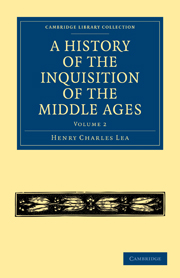CHAPTER II - FRANCE
Published online by Cambridge University Press: 29 August 2010
Summary
Although Catharism never obtained in the North sufficient foothold to render it threatening to the Church, yet the crusades and the efforts which followed the pacification of 1229 must have driven many heretics to seek refuge in places where they might escape suspicion. In organizing persecution in the South, therefore, it was necessary to provide some supervision more watchful than episcopal negligence was likely to supply, over the regions whither heretics might fly when pursued at home, or the efforts made in Languedoc would only be scattering the infection. Vigilant guardians of the faith were consequently requisite in lands where heretics were few and hidden, as well as in those where they were numerous and enjoyed protection from noble and city. Under the pious king, St. Louis, who declared that the only argument a layman could use with a heretic was to thrust a sword into him up to the hilt, they were sure of ample support from the secular power.
Accordingly when, in 1233, the experiment was tried of appointing Pierre Cella and Guillem Arnaud as inquisitors in Toulouse, a similar tentative effort was made in the northern part of the kingdom. Here also it was the Dominican Order which was called upon to furnish the necessary zealots. I have already alluded to the failure of the attempt to induce the Friars of Franche-Comté to undertake the work. In western Burgundy, however, the Church was more fortunate in finding a proper instrument. Like Rainerio Saccone, Frère Robert, known as le Bugre, had been a Patarin.
- Type
- Chapter
- Information
- A History of the Inquisition of the Middle Ages , pp. 113 - 161Publisher: Cambridge University PressPrint publication year: 2010First published in: 1888

